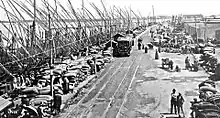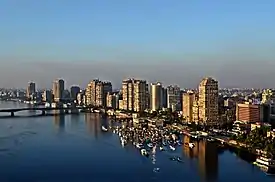Rod El Farag
Rod El Farag (Arabic: روض الفرج, Egyptian Arabic pronunciation: [ɾoːd elˈfɑɾɑɡ]; also spelled Road El Farag, Road Elfarag or Road Alfarag) is an administrative region forming about one third of Shobra in Cairo, Egypt. Rod El Farag neighbours the River Nile to the west, Boulaq to the south, Shobra (administrative region) to the east and Elsahel to the north. Rough Guides notes that like neighbouring districts, Rod El Farag is generally overcrowded (170,000 residents per square kilometre).[1]

Historically, Rod El Farag has been a residential area for centuries and was known in the early twentieth century for its night clubs. For many years, Rod El Farag was home to Cairo's biggest fruit and vegetable market and the world-famous El-Nozah candy shop, started in 1940. This candy shop was famous for its home-made ice cream,[2] though it relocated to an area on the outskirts of Greater Cairo.
The Rod El Farag market used to be the largest in all of Egypt, drawing regional farmers and traders to settle in the area.[3] The area where the market used to stand now hosts Rod El Farag Cultural Palace.[4]
This district also contains good infrastructure, including the French school "Notre Dame des Apotres." Located on the corniche is the Arkadia Mall, which contains stores such as Mobcco and the Trianon confectionery and cafe.
Rod El Farag Bridge
The Rod El Farag Bridge over the Nile river, which is part of the Tahya Misr Axis crossing the Egyptian capital of Cairo, built by the Egyptian company Arab Contractors, is the world's widest cable-stayed bridge[5] built over the course of 4 years until it was completed in 2019, achieving the Guinness World Record with a width of 67.3 meters.[6][7] The 540 meters long bridge has 6 lanes in each direction, has suspension towers which are 92 meters high and 160 suspension cables to hold the bridge. Currently, it is becoming a major tourist attraction in Cairo, where visitors can cross the side pedestrian passageways which have panoramic views of the banks of the Nile and a glass floor see-through walkway where visitors can walk over the Nile.[8][9][10]
References
- Bulaq, Shobra and Road El Farag, Rough Guides.
- Introduction to Egypt, Rough Guides.
- AljazeeraTalk.net
- Nehad Selaiha, Back to Rod El-Farag, Ahram Weekly, Egypt.
- http://en.wataninet.com/wp-content/uploads/2019/05/Image_9-3.jpeg
- "Egypt's Rod al-Farag Axis featured in Guinness World Records as widest suspension bridge". Egypt Today. Retrieved 17 May 2019.
- "Egypt's Sisi opens mega Rod El-Farag road, world's widest causeway". Al-Ahram. Retrieved 17 May 2019.
- "President Abdel Fattah El Sisi inaugurated "Tahya Misr" Axis and the Arab Contractors Company received Guinness World Records Certificate for "Tahya Misr" Bridge the World's Widest Cable Stayed Bridge". The Arab Contractors Company. Retrieved 17 May 2019.
- "Lifelines of Hope (documentary)". YouTube. The Egyptian Armed Forces. Retrieved 17 May 2019.
- "Watch: Egyptians' happiness after passing over the Rod El Farag Bridge and its glass walkway". YouTube. Dot Masr (Youm7). Retrieved 17 May 2019.

